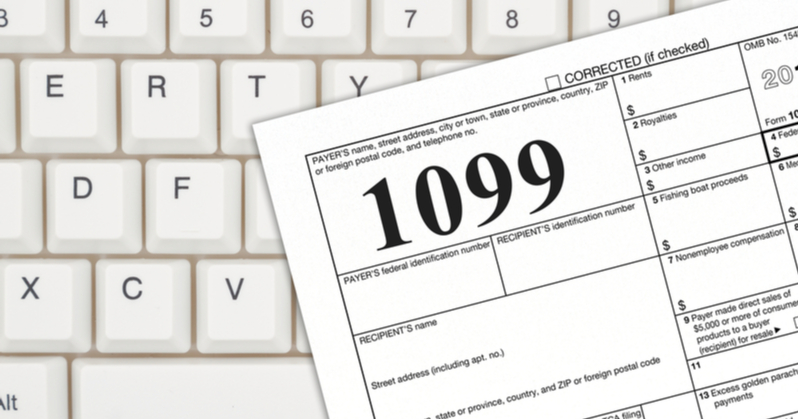Another 1099 filing season was passing. As I struggled to obtain information to file those pesky forms, I thought there must be a better way to collect it. Every year I say, “I have to come up with a better process and have the clients collect this data during the year.” And every year, I experience the same thing again.
Then I saw a tweet from one of my favorite people to follow, Kelly Phillips Erb (@taxgirl):
“I wish more advisors would stress the importance of collecting Forms W-9 at the start of a business relationship. This time of year, my inbox is full of inquiries about how to get folks to fill them out after they've been paid, and emails from folks who don't wish to do it. #tax”
She followed up with:
Also important: as a #freelancer or #independentcontractor, you do not have to "agree" to receive a Form 1099. There is no "opt-out." I don't know where that misinformation started, but receiving the form if you meet the criteria is the result of a law, not a conversation. #tax
I realized I was not the only one that struggles with this. Many replies agreed that the first payment to a vendor should not occur until the W-9 is completed. However, this is easier said than done. For someone who believes 110% in process, procedure and automation, I find it hard to believe that the marketplace has not addressed this process.
The filing of 1099s can be done through many providers out there. They make it easy to electronically file the returns and distribute them to recipients. Many of them will also allow you to send in bulk W-9 requests. But how do we manage that process from end to end? Why is it so important?
It all starts with getting that Form W-9
It is critical to obtain a Form W-9 before you make the first payment to a new vendor or independent contractor. This will save tremendous time at year-end and reduce potential IRS penalties. The W-9 form provides you with the vendor’s legal name, TIN number, tax classification, address and exemption/FATCA status. This information is used to process a Form 1099 at year-end, if required.
The “if required” is a huge qualifier. First, most people completing a Form W-9 do not always know what exactly they are completing and why it is important. Second, many people simply send W-9 requests to individuals whom they believe they will pay over $600. The rules for 1099s and other information returns are much more complex. You are not required to file a 1099 simply because a vendor completes a W-9.
Avoid backup withholding and reduce risk of penalties
You can avoid the requirements for backup withholding, which can be very onerous and time-consuming, by obtaining a W-9 in advance. If you do not obtain a W-9, the IRS requires you to withhold 24% of the reportable amounts paid to the vendor. Then you also must file Form 945 timely and remit those withholdings to the IRS. This turns into another very time-consuming process that creates opportunities for errors and potential penalties for misfiling those Forms 945.
If you wait until the end of year to try and get W-9s from vendors, you run the risk of not receiving necessary information. This may result in not filing a 1099 that should have been filed. It also does not allow you to withhold that 24% backup withholding. You now risk the possibility that you will be responsible for paying that 24% directly (after already paying 100% to your vendor). You also risk being assessed penalties for the late filing of an information return. This could also require you to file additional 1099s for the withholding.
The penalties for information returns submitted late to the IRS are as follows:
- $50 per information return if you correctly file within 30 days (by March 30 if the due date is February 28); maximum penalty $571,000 per year ($199,500 for small businesses).
- $110 per information return if you correctly file more than 30 days after the due date but by August 1; maximum penalty $1,713,000 per year ($571,000 for small businesses).
- $280 per information return if you file after August 1 or you do not file required information returns; maximum penalty $3,426,000 per year ($1,142,000 for small businesses).
The IRS defines “small business” for purposes of these penalties as averaging $5 million or less in annual gross receipts for the business’s three most recent tax years.
Unfortunately, I think that if my client ever gets a penalty like this, it will somehow be my fault that they did not follow my suggestion: Do not send anyone that first payment without obtaining the W-9.
My vision of an automated W-9 and 1099 management system
I'm a believer of two things. First, process, procedure and automation are critical. Second, software vendors should do what they do best in their area and not try and be all things to all people. In other words, an add-on solution that manages the full process from W-9 to 1099 is most likely necessary for full automation.
Here is my vision of a software solution that manages the W-9 and 1099 process for you automatically. As you read through these steps, consider what your current software handles and if your current software alleviates or adds to your stress.
The automated solution starts with obtaining W-9s
- 1. An invoice is received/entered into the bookkeeping system.
- 2. Solution checks if the vendor record has an associated taxpayer identification number (TIN).
- If so, proceeds with the Accounts Payable bill payment process.
- If no TIN is present, places a hold on payment of the invoice until a W-9 is received from the vendor.
- 3. Solution obtains W-9 from the vendor.
- a. Solution sends initial email request (with scheduled follow ups as needed) to the vendor with an easy to complete question and answer format to help the vendor correctly complete the W-9.
- Solution tracks whether the email was opened and the status of completion.
- Solution sends reminder emails.
- Solution makes automated phone calls.
- b. Solution processes the W-9 once the vendor completes the W-9 digitally.
- Completes a TIN matching process to confirm that the data is correct.
- Notifies the vendor that it is now eligible for payment.
- Confirms the type of 1099 to be filed at year-end.
- Attaches a PDF copy of the W-9 to the vendor record in the bookkeeping system.
- Removes the payment hold and notifies the AP clerk that the invoice is now eligible for payment.
- c. Solution syncs any change of address with the bookkeeping system.
- 4. Solution searches for any other vendors that have been paid and who do not have a TIN each time a new vendor is created. If such a vendor is located, the solution goes through steps 1-3 above.
The automated solution process 1099s
By using an automated solution that performs the steps outlined above, January becomes a much calmer month for 1099 processing. My ideal solution would take the following steps:
1. Solution retrieves financial data for vendors eligible for 1099s.
2. Solution processes 1099s, including:
a. Efiles 1099s.
b. Emails and mails copies of 1099s to recipients.
c. Attaches PDF copies of 1099s to the bookkeeping records.
d. Provides digital copies to be saved directly to the document management system.
e. Automatically notifies when efile submission has been accepted.
Summary
Annual 1099 processing is fraught with potential issues and penalties. If a process for vendor management is not defined, implemented and followed throughout the year with each vendor added, 1099 processing becomes far more compressed during tax season.
Note to software developers: If you would like to develop a program to follow this process, just send me a (monetary) notification after each successful 1099 submission! [Said with a smiley face emoji 😊 as I like to see smiles!]
.png?width=150&height=63&name=TWRlogo-regmark_blueblack%20(1).png)
.png)










Do you have questions about this article? Email us and let us know > info@woodard.com
Comments: